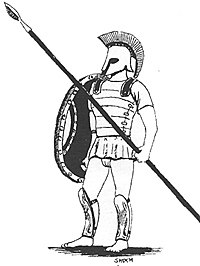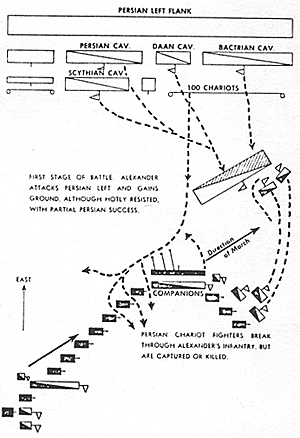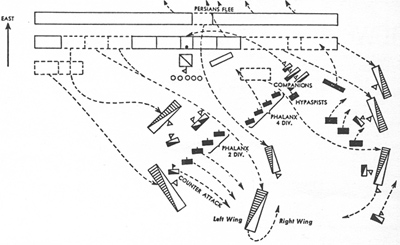 The question of where data on ancient battles and campaigns can be found has often been asked since the game ALEX was released. Particularly, accurate information
regarding organization, orders of battle, dispositions, and tactics.
The question of where data on ancient battles and campaigns can be found has often been asked since the game ALEX was released. Particularly, accurate information
regarding organization, orders of battle, dispositions, and tactics.
Well, as much as I hate to say it, boys, the chroniclers of ancient battles were less than exact. Now the truism of the victor writing the history of war is particularly applicable to the ancient era, and the feats of the victors and the numbers of vanquished are usually grossly exagerated.
Whenever you are using primary sources (Tacitus, Heroditus, Arrian, Polybius, etc.) or secondary sources which accept them at face value, be particularly skeptical of numbers, both of the enemy and casualties suffered by them. As a case in point, I cite both Sir Edward Creasy and J. F. C. Fuller (in DECISIVE BATTLES) numbering the Persian Host set at upwards of 1,000,000! As there are a few afterthoughts about ALEXANDER THE GREAT that need to be expressed anyway, a brief recounting of the research and design that went into the game, along with the afterthoughts, might be of interest to those who mean to design some game or rules of their own.
Sources
The main sources used are listed below. They will be referred to hereafter simpy by the first main word of their titles:
- FIFTEEN DECISIVE BATTLES OF THE WORLD Sir Edward S. Creasy
DECISIVE BATTLES Major General J. F. C. Fuller
THE GENERALSHIP OF ALEXANDER THE GREAT Fuller
THE CAMPAIGN OF GALIGAMELA E. W. Marsden
THE LIVES OF THE NOBLE GRECIANS AND ROMANS Plutarch (Dryden Translation)
Before any attempt at design is undertaken it is advised that the researcher ground himself in the period in question; that is not only the battle, campaign or war, but in all those salient aspects recorded prior to the event which brings the affair into historical prospective. A good general work like THE CAMBRIDGE ANCIENT HISTORY is highly recommended. LIVES was helpful to the design of ALEX in this respect, as were several works on Classical Greece.
Finding out how the armies of a particular city-state, nation, empire, or what have you were organized can pose particular problems. In many cases it will be necessary to ready everything available, and pick out this information piecemeal from many sources. GENERALSHIP, fortunately, provided almost everything needed regarding the Macedonian Army. Surprisingly, books of costumes and uniforms (such as FUNCKENS' book) will often supply much of this kind of information also.
Once the information is obtained it must be decided how you will fit it into your design. For example, the Macedonian Phalanx was divided into six TAXES, but in a game of ALEX's scale these small formations would be out of place so the larger historical subdivision were used instead. The latter choice prevents the players from exactly duplicating the events of the battle, but the overall game was found to be improved thus.
 Orders Of Battle
Orders Of Battle
Orders of Battle and disposition of units must also often be painstakingly dredged from rambling accounts of battles, with each scrap of information so gleaned noted on a diagram. Eventually, some reasonably correct order of battle and battle array can often be attained in this manner.
Many times, however, the author will have provided much of this information for you, but two sources seldom agree totally. Note the differences in the diagrams. It will be up to you to arrive at what YOU believe to be best, historically and game-wise. The interprptation of ancient history cannot be more than supposition, speculation, and theory in most cases as there is little concrete information to go by. Of course, greater credence must be given to the more scholarly efforts and the best documented and logical assertions.
Those who have read CAMPAIGN or noted Donald Greenwood's article "331 B.C." (PANZERFAUST No. 52) may question the number of infantry counters given the Persians in ALEX in light of Marsden's diagram of Darius' battle array.
Now Professor Marsden asserts that there weren't many footmen involved in the battle, using reasoning somthing like this: The army raised by Darius was the second one gathered in little over a year, small trust could be placed in masses of partially trained infantry, and nothing was heard of them in the battle. This form of reasoning does not seem to stand up under questioning. Unquestionably Darius gathered as large a body of cavalry as possible to serve as a counter to the invaders' heavy horse, but there is no reason to suppose that this would preclude calling in the footmen from the various parts of the empire. These levies are mentioned specifically in fact. Ancient accounts tell of infantry from five to twenty times more numerous than the cavalry; even with reasonable deflation a body of 60,000 or 70,000 footmen can be deduced. Logically, Darius could well have hoped to dishearten the enemy by the mere sight of such masses.
Again, Marsden included the 15 elephants of which there is evidentally no mention as to their employment in the battle. Considering the manpower pool available to Darius, and the amount of time Alexander allowed him to utilize it, 100,000 infantry would not be out of line.
By carefully comparing and contrasting the information available something close to the truth can possibly be achieved. In order to obtain the data you desire, I suggest that you get whatever is available at the local library. It being found to be insufficient, check the bibliography or footnotes for the sources used. In this manner it is usually possible to gather more than enough information (or at least all that is available to a researcher who reads in English only) to work up the design. Most libraries now have inter-facility services, so that books from large cities and university libraries are available in a week or two. Failing this, you can always buy the more recent works and have book finders locate out of print material. Fight on.
One or two persons have mentioned that there is sometimes difficulty in bringing the opposition to battle. Now, ancient armies just did not make a practice of falling back in the face of an enemy advance, for such a retrograde could all too easily end in a panic and rout. In this regard, then, I am sugesting that later editions of the game include the following ADVANCED GAME rule:
 RETROGRADE MOVEMENTS
RETROGRADE MOVEMENTS
Either side may fall back after advancing from their Start Lines, but at any time the main line of battle (the majori- ty of units) is BEHIND the Start Line that side suffers the following penalty:
- A. One hex behind Start Line -1 Morale Point
B. Each additional hex behind Start Line-2 Morale Points/hex
Maps from Creasy, adapted by Fuller in DECISIVE
This rule applies only on the first day of battle as far as the Start Lines are concerned (rows M and U). However, should either or both of the players elect to start the second day of play from a position behind the regular Start Lines then it will apply to the new starting row. If they start on the regular Start Lines on the second day of the game then the rule applies to the Start Lines as if it were the first day of the game.
There is one change I have considered off and on since the game was released. The Macedonian cavalry might be undervalued just a bit, so changing the Landers to 4+2 21, the Ocrysians and Paeonians to 3+, 2, 2, I's couli be iried. Likewise, the Persian infantry might be slightly overvalued, and an adjustment of all save the Indian, Median, and Persian to 2, 1, 1, 0 would not be out of line.
These changes would reflect the better method of fighting on the part of the Macedonian cavalry and the small value of the bulk of the Persian foot troops.
Tactical usages of troops will most likely pose many questions too. One of the things that still bothers me is the use of cavalry as a SHOCK force by Alexander. One would suppose at first glance that the phalanx would be the CORPS DE RUPTURE of the Macedonian Army, but quite to the contrary. GENERALSHIP tells of sarissa armed horsemen (the "Scout-Lancers" of CAMPAIGN), and any study of the battle of Gaugamela reveals that the Companion Cavalry broke the Persian line. Now the light cavalry operating as skirmishers and missile troops is understandable, but how the heavies operated -- and the Persians also supposedly had some -- without benefit of stirrups in their role is beyond this poor wargamer.
You will note in the diagram from CAMPAIGN that the Scouts (Lancers) and Companions are shown in triangular formation, and the Thessalion cavalry is depicted by rhombus-shaped markings. These were the formations adopted by these troops in battle.
 Having all I could do to talk Guidon into producing a game with three
different sizes of unit counters, I didn't want to press my
luck further. Besides, while such an array would be
meaningful to the miniaturist, it makes no difference in a
board game where combat capabilities are expressed in
factors. Esthetically it is a different story, but sacrifices
must be made ... The major tactics of an army are usually
fairly easy to discover, so I will not dwell upon this
aspect. Diagrams of the first and second stages of the
battle of Gaugamela amply illustrate the point (see
below). However, it is interesting to note the array given
in CAMPAIGN, where the right wing of Alexander's force
is depicted as parallel to the Persians. FIFTEEN and
DECISIVE both show the wing as refused. I believe
Marsden to be in error on this point also, for the final
wedge that Alexander employed to roll up the Persian
left-center and center would be much more easily formed
from the latter position.
Having all I could do to talk Guidon into producing a game with three
different sizes of unit counters, I didn't want to press my
luck further. Besides, while such an array would be
meaningful to the miniaturist, it makes no difference in a
board game where combat capabilities are expressed in
factors. Esthetically it is a different story, but sacrifices
must be made ... The major tactics of an army are usually
fairly easy to discover, so I will not dwell upon this
aspect. Diagrams of the first and second stages of the
battle of Gaugamela amply illustrate the point (see
below). However, it is interesting to note the array given
in CAMPAIGN, where the right wing of Alexander's force
is depicted as parallel to the Persians. FIFTEEN and
DECISIVE both show the wing as refused. I believe
Marsden to be in error on this point also, for the final
wedge that Alexander employed to roll up the Persian
left-center and center would be much more easily formed
from the latter position.
The design of an ancient game or set of ancient war game rules for miniature battles is difficult because the designer must first educate himself in the period, then assemble the various historical parts, assess their relitive value as sections of the whole, turn them into a playable contest, and still maintain a reasonable amount of historical realism. The vagueness of ancient histories and battle accounts makes this a real headache, and the designer might well find himself continually revising parts of his work as he is swayed by first one account and then another.
Avoid this by careful research in all the material that you can obtain, arrive at what you consider to be the most plausable account by combining the information gathered, and then forget the whole thing once it is done. Avalon Hill seems to follow this practice with their games, letting the players argue amoung themselves afterward just where the "X" division or what have you was.
Actually, I am still pretty well satisfied with ALEX, for it provides a fairly fast, well-balanced, and historically accurate depiction of the battle in question. What's more, it is not overly complicated as to destroy plausibility. Only the passage of time will attest to its variety and tactical complexity. While I have yet to hear of any revisions that are required to make it a better game, I am still open to suggestions, for I'll be the first to admit it is far from perfect! Mr. Greenwood's suggestions about historic placement are well taken. Second I believe that the next edition of the game should include both that shown in FIFTEEN and that of CAMPAIGN.
Back to Table of Contents -- Panzerfaust #59
To Panzerfaust/Campaign List of Issues
To MagWeb Master Magazine List
© Copyright 1973 by Donald S. Lowry.
This article appears in MagWeb (Magazine Web) on the Internet World Wide Web.
Other military history articles and gaming articles are available at http://www.magweb.com